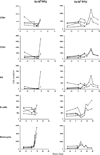Small particle aerosol inoculation of cowpox Brighton Red in rhesus monkeys results in a severe respiratory disease
- PMID: 25776759
- PMCID: PMC4535421
- DOI: 10.1016/j.virol.2015.02.044
Small particle aerosol inoculation of cowpox Brighton Red in rhesus monkeys results in a severe respiratory disease
Abstract
Cowpox virus (CPXV) inoculation of nonhuman primates (NHPs) has been suggested as an alternate model for smallpox (Kramski et al., 2010, PLoS One, 5, e10412). Previously, we have demonstrated that intrabronchial inoculation of CPXV-Brighton Red (CPXV-BR) into cynomolgus monkeys resulted in a disease that shared many similarities to smallpox; however, severe respiratory tract disease was observed (Smith et al., 2011, J. Gen. Virol.). Here we describe the course of disease after small particle aerosol exposure of rhesus monkeys using computed tomography (CT) to monitor respiratory disease progression. Subjects developed a severe respiratory disease that was uniformly lethal at 5.7 log10 PFU of CPXV-BR. CT indicated changes in lung architecture that correlated with changes in peripheral blood monocytes and peripheral oxygen saturation. While the small particle aerosol inoculation route does not accurately mimic human smallpox, the data suggest that CT can be used as a tool to monitor real-time disease progression for evaluation of animal models for human diseases.
Keywords: Aerosol inoculation; Animal model; CT; Computed tomography; Cowpox; Orthopoxvirus; Pathogenesis.
Published by Elsevier Inc.
Figures







References
-
- Anon Annual Report to Congress. Department of Defense, Chemical and Biological Defense Program. 2009
-
- Bray M, Buller M. Looking back at smallpox. Clin. Infect. Dis. 2004;38:882–889. - PubMed
-
- Bray M, Martinez M, Smee DF, Kefauver D, Thompson E, Huggins JW. Cidofovir protects mice against lethal aerosol or intranasal cowpox virus challenge. J. Infect. Dis. 2000;181:10–19. - PubMed
Publication types
MeSH terms
Substances
Grants and funding
LinkOut - more resources
Full Text Sources
Other Literature Sources

